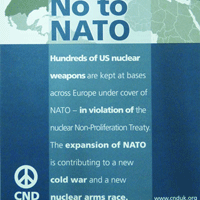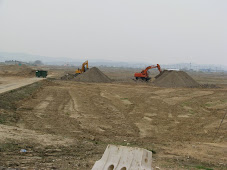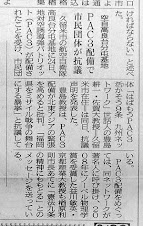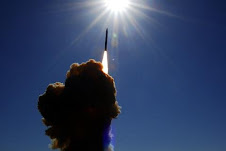
* Image source/ caption*
Same as the article below.
“Gaseong Industrial Complex buildings are visible behind a North Korean guard post taken on April 2 by the Dora observatory, a briefing center located in the southern area of the DMZ.”
http://english.hani.co.kr/arti/english_edition/e_northkorea/347792.html
N. Korea and Japan exchange retaliatory warnings regarding launch:
Expert believes N. Korea could have a successful launch, and it has not secured technology to miniaturize nuclear warheads
Posted on : Apr.3,2009 12:30 KST
With North Korea’s into to launch a “satellite” into orbit entering the countdown stage, a battle of wills between North Korea and Japan, as well as other nations, looms large. While the Japanese government makes gestures that some analysts indicate may be intended to exploit North Korea’s launching of a satellite as a political pawn to improve approval ratings, North Korea attempts to minimize the aftermath.
In an “important announcement” on April 2, a spokesman for the General Staff of North Korea’s military said, “It is the Japanese reactionaries, the sworn enemy of the Korean people, who are perpetrating the most evil doings over the DPRK’s (North Korea’s) projected peaceful satellite launch.” The representative of the Korean People’s Army also added If Japan recklessly ‘intercepts’ the satellite, it will “mercilessly deal deadly blows not only at the already deployed intercepting means but at major targets.” North Korea also warned South Korea and the United States, however with taking a softer tone, saying they should immediately withdraw its already deployed armed forces if it does not wish to be hurt” and ”should refrain from disturbing the launch.“
Analysts suggest North Korea’s “important announcement” is seen as a bluff against a bluff. Japan’s order to shoot down North Korea’s “satellite” is based on the presumption that the satellite or any of its debris falls onto its soil after failing to make it into orbit. If the “satellite” launched proceeds successfully as North Korea anticipates, there would be little reason for Japan to shoot down it. The announcement is seen as a justified retaliatory move against the Japanese government, who is at the forefront of advocating for hawkish actions against North Korea, including interception and sanctions.
No one is certain, however, that the situation will result in a mere war of words because North Korea has moved a squadron of MiG-23 fighter jets to a base near the launch site in what has appeared to be a response to Japan’s deployment. Experts suggest that In the worst-case scenario, if Japan shoots down North Korea’s “satellite,” North Korea’s MiG-23 fighter jets could attack Japan and South Korea’s Aegis-equipped destroyers, which were deployed Saturday to the East Sea. They also indicate that the possibility of an accidental conflict cannot be ruled out, for instance if North Korea’s MiG-23 fighter jets try to block access to U.S. spy planes.
Kim Byeong-yong, a researcher at the Korea Institute for Defense Analyses, a South Korean think tank, believes that North Korea’s launch may succeed, given its experiences gained from launches of its Taepodong-1 and Taepodong-2 missiles as well as technological cooperation with Iran, which successfully launched a satellite in February. Moreover, Kim, who spoke recently at an academic forum organized by the Institute for National Security Strategy, says he does not believe North Korea has secured technology to miniaturize a nuclear warhead, or developed a reentry technique for intercontinental ballistic missiles.
Please direct questions or comments to [englishhani@hani.co.kr]
© 2006 The Hankyoreh Media Company.

![[URGENT PLEA: In Update] EMERGENCY in GANGJEONG Since AUG. 24, 2011](http://2.bp.blogspot.com/-3iz8k-USXVY/TlmRYhhIYtI/AAAAAAAAL2c/9dbF85ZIkIs/s227/jejusit.jpg)



![[Solidarity from Japan for the Jeju] 253 individuals and 16 groups/organizations](http://2.bp.blogspot.com/_gnM5QlRx-4c/TR_YeNVE1yI/AAAAAAAAHWQ/ARyf6oQN0S0/S227/jeju_12_10j.jpg)

![[Translation] Korean organizations' statement: Immediately cancel the joint ROK-US drill Nov 26](http://2.bp.blogspot.com/_gnM5QlRx-4c/TPOE8VKXHFI/AAAAAAAAGlM/8lryt-8sFjc/S227/1.jpg)
![HOT! [Hankyoreh Hani TV] Beneath the Surface: the investigation into the sinking of the Cheonan](http://4.bp.blogspot.com/_gnM5QlRx-4c/TOI83qht8aI/AAAAAAAAGXU/22SW6Q5ntV8/S227/HaniTV%2BCheonan.gif)



![[Translation]Statement against illegal inspection and unjust lay-off by the Kunsan USAFK!(Nov_2010)](http://4.bp.blogspot.com/_gnM5QlRx-4c/TOPLsVkZMqI/AAAAAAAAGZs/3YnnckIyAaY/S227/gunsan%2Bprotest.gif)
![[Translation] Korean organizations' statement against dispatching special force to the UAE on Nov.](http://4.bp.blogspot.com/_gnM5QlRx-4c/TOP95zHXlCI/AAAAAAAAGak/E0Ug1XtUFfM/S227/antiwarpeace.jpg)
![[Translation] Stop, Joining MD!: South Korean activists' statement and writing on Oct. 25, 2010](http://3.bp.blogspot.com/_gnM5QlRx-4c/TOP7Es4_2sI/AAAAAAAAGac/eWVMPD-U4p0/S227/StopMD.jpg)
![[In Update] People First, NO G-20 (Nov. 6 to 12, Korea)](http://2.bp.blogspot.com/_gnM5QlRx-4c/TJd53XBzHlI/AAAAAAAAFQo/ldO9JPE3eqo/S227/left21_G20.jpg)
![[International Petition] Stop US helipad plan in Okinawa to save great nature](http://4.bp.blogspot.com/_gnM5QlRx-4c/TKC2AHRNzBI/AAAAAAAAFUo/yGWXODTw_uM/S227/yanbaru_w.jpg)

![[Global Network] against the first launch of Quasi-Zenith Satellite, Japan, on Sept. 11, 2010](http://4.bp.blogspot.com/_gnM5QlRx-4c/TIowa1boy4I/AAAAAAAAFDI/82rAi98uq-c/S227/Qzss-45-0_09.jpg)

![[In update] Some collections on the Koreans’ protests against the sanction & war on Iran](http://4.bp.blogspot.com/_gnM5QlRx-4c/TJMvke6t8zI/AAAAAAAAFO4/tamQ8LUnOOA/S227/No+Sanction+on+Iran.jpg)
![[Three International Petitions] to End the Korean war and peace treaty(or peace resolution)](http://1.bp.blogspot.com/_gnM5QlRx-4c/THef7bzWxYI/AAAAAAAAE44/wwdzSDfYhdw/S227/border.jpg)



![[Collection of Documents] No Base Learning and Solidarity Program_Korea(June 14 to 20, 2010)](http://1.bp.blogspot.com/_gnM5QlRx-4c/TCTvVuN8NeI/AAAAAAAAEek/8vBJVaHdk10/S227/No-Base-banner.jpg)
![Site Fwd:[John Hines] A U.S. Debate coach’s research trip on the Issues of Korea](http://3.bp.blogspot.com/_gnM5QlRx-4c/TINCO36mzzI/AAAAAAAAE_w/Rds12NcBOXM/S227/Jeju-Peace-Tour.jpg)


![[News Update] Struggle Against the Jeju Naval Base since Jan. 18, 2010](http://1.bp.blogspot.com/_gnM5QlRx-4c/S1vvWaP25uI/AAAAAAAACkg/QvpW1tgOlKM/S226/scrum1.jpg)


![[Urgent] Please spread the Letter!: There was no Explosion! There was no Torpedo! (May 26, 2010)](http://4.bp.blogspot.com/_gnM5QlRx-4c/S_9JmsKEU7I/AAAAAAAAEP8/sAWjSPqxzUI/S227/grounded.jpg)
![Text Fwd: [Stephen Gowans]The sinking of the Cheonan: Another Gulf of Tonkin incident](http://1.bp.blogspot.com/_gnM5QlRx-4c/TAL_FtYKQ-I/AAAAAAAAERE/NEEMijiEcRM/S227/lee-myung-bak.jpg)
![[Japan Focus]Politics in Command: The "International" Investigation into the Sinking of the Cheonan](http://1.bp.blogspot.com/_gnM5QlRx-4c/TBMJ2syJzyI/AAAAAAAAEZU/uTYZccU5vyk/S227/wen_jiabao_and_lee_myungbak.png)
![[Japan Focus] Who Sank the SK Warship Cheonan? A New Stage in the US-Korean War and US-China](http://2.bp.blogspot.com/_gnM5QlRx-4c/S_iQ2vE5ZpI/AAAAAAAAEOU/Oo1SPcAe8FE/S227/buoy_map.gif)
![[Updated on 12/13/10] [Translation Project] Overseas Proofs on the Damages by the Military Bases](http://4.bp.blogspot.com/_gnM5QlRx-4c/S-qSj59gPLI/AAAAAAAAEGM/mwjlFtPE-jo/S227/missile.jpg)
![[International Petition] Close the Bases in Okinawa](http://3.bp.blogspot.com/_gnM5QlRx-4c/S8-z3DYNwNI/AAAAAAAADo4/OswTSchK09M/S227/2.jpg)

![[In Update]Blog Collection: No Korean Troops in Afghanistan](http://4.bp.blogspot.com/_gnM5QlRx-4c/SwnlLD9IewI/AAAAAAAAB9E/oUPssnpNidA/S226/No-Troops-to--Afghanistan.jpg)











No comments:
Post a Comment